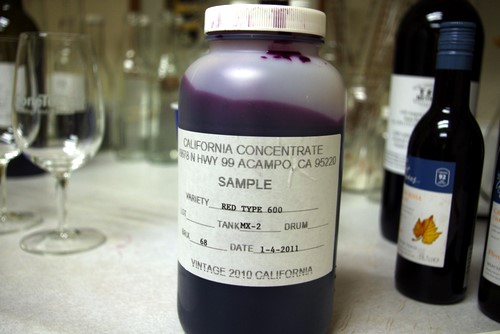Wine is unusual among foodstuffs in that it doesn’t contain ingredient labelling or lists. All that is required is the statement ‘contains sulfites’ if the total sulfur dioxide level exceeds 10 mg/litre (which is a level that can be achieved even when no sulfites are added; they are made by yeasts, too).
There have been calls for ingredients labelling to be made mandatory for wine. Some of these calls have come by more natural winegrowers who add very little or nothing at all to their wine: they think this would highlight to consumers just how many additives are used in the production of commercial wines.
For example, famed Californian winery Ridge decided that from the 2011 vintage, all additions would be indicated on the label, in a bid to differentiate their wines, made pretty naturally, from those that are more manipulated.
We believe that for anyone attempting to make fine wine, modern additives and invasive processing limit true quality and do not allow the distinctive character of a fine vineyard to determine the character of the wine.
Ridge is adding to its labels a list of actions and ingredients to demonstrate how little intervention is necessary to produce a fine, terroir-driven wine from distinctive fruit. Although an ingredient list is not required by the TTB, if a winery chooses to add a list of ingredients to its back label it must list ALL ingredients.
A large segment of the wine industry is resistant to these calls. They worry that if consumers were to see behind the scenes of commercial winemaking, and the realise sorts of manipulations and additions that take place, then they’d be horrified and there would be a backlash. Most consumers think wine is pretty natural. The commercial guys want to keep up this impression.
If you are a natural winegrower, you’d think that ingredient labelling would work in your interests. Horriified by the industrialization of wine, consumers would opt for the more naturally made bottles.
But be careful what you wish for. Ingredient labelling could put a lot of natural wine producers out of business. Why?
Because of the legislative burden it would impose. Think about I. If ingredient labelling were required by law, there would be attendant testing by registered laboratories. Even if you didn’t add anything to your wine, you’d have to send it off for testing. This would be for every bottling run. Now this isn’t a huge burden for a large commercial outfit. But for a small grower making limited quantities of a number of wines, this would be a huge cost.
Then there would be labelling requirements, and appropriate translations for each export market. You can see where all this is going: a new group of testing labs, compliance officers and label translators would spring up as a fresh set of parasites on the back of the hard work of the wine growers.
Would the public be any better off? UK retailer the Co-Operative already have ingredient labelling on the back of all their wines. I suspect most customers never read it, and even if they do, are just a little bemused by some of the winemaking additive names. Most consumers ignore back labels. To them, it is just wine, whether or not it has the ‘ingredients’ listed.
Be careful what you wish for.
9 Comments on Ingredient labelling in wine


Then develop a traffic light system. Or scratch and sniff where the consumer breathes in a good effective pesticide. The point is, it should be communicated – ie what has been sprayed on the vines (organic certification is ‘mature’ enough now I think for this) and what has been used in the making of the wine. Not easy, but then if done the consumer can make a more informed decision. I still wish for it!
Jamie.. you should listen to this interview.
http://www.heritageradionetwork.com/archives?tag=Jared+Brandt
Velcorin is an allowed additive.. this kills all microbial live in wine.. listen to this interviw on additives.. very interesting and really lays out some interesting arguments.
You know what its tricky.. I just buy from produers whom I know what they put in or don’t .. however the 99.999
percent don’t know that some very nasty stuff is going in their wine.. (Not Mega Purple)
so its tricky.. I don’t care as I don’t generrally drink wine from giant corporations but .. most people do.. and don’t know..
Disclosure.. I am friends with the wine maker.
Nine minutes into that interview I got a headache.
Okay why so snarky? Anders? If you don’t like it you don’t have to insult me by insultin it
You said there were some interesting arguments. I just found the usual innuendos and nonsensical statements like wine ”has a soul” and that wine is ”a living thing”. That’s why.
There is one label aspect that consumers do care about and that is SO2 level. The “contains sulphites” is not that helpful. Having the label state the exact amount or an indicator of the level e.g. “not more than 50” would be well received.
Jamie, I don’t get your argument that natural wine producers would have to test for ingredients if they don’t add anything. Ingredients lists wouldn’t require chemical compounds; they would just require what you put into the vat.
Paul Rickett: I entirely agree. At the recent RAW wine fair, the added sulphite levels fell into 3 categories (broadly). (1) organic levels, like me, say around 75 g/l, (2) those ‘nearly natural’ that only add just before bottling, say around 40g/l, and natural, with none or < 10 g/l. I have to say, the wines from category (2) surprised me; very good in the main, and I perceived more flavours, more refinement, and hardly any brett. Not scientific by a long way but a nice surprise. In the natural category (3), though, there were some faults, unfortunately. I think as the public get more educated about this, having a recognisable categorisation along those lines would be good, and helpful. And that is just suphites…not even got onto other additives…
Geisenheim University along with two other Institutes were commissioned to carry out a 3 year project (available through the OIV), regarding fining agent residues in wine. They developed accurate ELISA methods which can detect levels down to 1ppb. Using a large range of wines from around the world (that were produced using different fining agents). They found no residues because all the wines had been filtered after fining. Therefore on this basis the OIV is not going to recommend to the EU that fining agents should be listed on labels.
One point raised was unfiltered wines which are not usually subjected to fining anyway!
The only way it would be questioned is if someone in the medical profession could state the dangerous limit of the particular fining agent in wine! It is unlikely anyone will in case they are proved wrong and under estimate the amount.
While I realise fining agents are not the only “additives” used in some winemaking, the EU regulations are unlikely to demand ingredient labelling unless
a) the medical profession can state the limit that the additives are dangerous to human health
b) methods are available or developed to detect at these levels in a wide range of additives
c) the WHO become involved in the topic of listing ingredients in which case it is back to a and b.
I thought another viewpoint might be interesting!